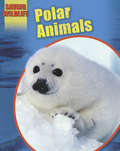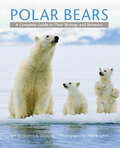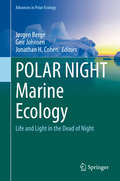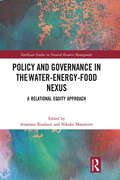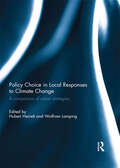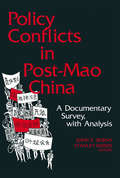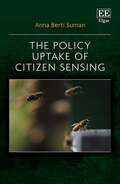- Table View
- List View
Poison Spring: The Secret History of Pollution and the EPA
by E. G. Vallianatos McKay JenkinsImagine walking into a restaurant and finding chlorinated hydrocarbon pesticides, or neonicotinoid insecticides listed in the description of your entree. They may not be printed in the menu, but many are in your food. These are a few of the literally millions of pounds of approved synthetic substances dumped into the environment every day, not just in the US but around the world. They seep into our water supply, are carried thousands of miles by wind and rain from the site of application, remain potent long after they are deposited, and constitute, in the words of one scientist, “biologic death bombs with a delayed time fuse and which may prove to be, in the long run, as dangerous to the existence of mankind as the arsenal of atom bombs.” All of these poisons are sanctioned--or in some cases, ignored--by the EPA. For twenty-five years E.G. Vallianatos saw the EPA from the inside, with rising dismay over how pressure from politicians and threats from huge corporations were turning the it from the public's watchdog into a "polluter's protection agency." Based on his own experience, the testimony of colleagues, and hundreds of documents Vallianatos collected inside the EPA, Poison Spring reveals how the agency has continually reinforced the chemical-industrial complex.Writing with acclaimed environmental journalist McKay Jenkins, E.G. Vallianatos provides a devastating exposé of how the agency created to protect Americans and our environment has betrayed its mission. Half a century after Rachel Carson's Silent Spring awakened us to the dangers of pesticides, we are poisoning our lands and waters with more toxic chemicals than ever.
Poisoned Spring: The EU and Water Privatisation
by Kartika Liotard Steven P. McGiffenVast numbers of people have no access to safe drinking water, and even more lack any kind of effective sanitation. Most of the world's water supply remains in public ownership. Neither drought nor flood is as much a meteorological phenomenon as it is the result of mismanagement. So is privatisation the route to solving this most urgent of problems?*BR**BR*The authors argue that, on the contrary, neoliberal economics and the power structures responsible for widening global inequalities are blocking the way to progress towards universal provision of safe water and effective sanitation. Behind these malign influences stands the growing power of the European Union and the corporations in whose interests it operates. *BR**BR*On the basis of an analysis of the political economy of water and of the European Union's policies, Poisoned Spring will place the problem of water supply in the broad context of corporate control of the world's resources.
Polar and Climate Change Education: Citizen Science and Sustainability (Research and Teaching in Environmental Studies)
by Gisele ArrudaThis book presents ideas for strengthening the foundations for transformational change in polar and global education leadership in all stages of the education process.Despite being an established concept endorsed by the United Nations Educational, Scientific and Cultural Organization (UNESCO), Education for Sustainable Development (ESD) is still not in the educational mainstream but is vital in mitigating against the intensifying impacts of global change and adapting to the shifts that have already occurred. Drawing on examples from real world projects in the United States, Germany, Mexico, Japan, Peru and Greenland, this book assesses the new educational strategies, pedagogies and technologies which have been adopted by polar educators to stimulate students’ interests in sustainability and re-orient education to global citizenship science. The experiential nature of the pedagogies shown in the case studies and educational activities builds background knowledge of cutting-edge research and empowers participants to communicate authentic research practices and show how data collection in the polar region is applicable in other parts of the globe.Highlighting the many ways in which educators for global citizenship can have a decisive role in transforming individuals and society, this book will be of great interest to students and scholars of climate change, education and Arctic studies. It will also be a valuable resource for professional educators working in ESD.
Polar and Climate Change Education: Citizen Science and Sustainability (Research and Teaching in Environmental Studies)
This book presents ideas for strengthening the foundations for transformational change in polar and global education leadership in all stages of the education process.Despite being an established concept endorsed by the United Nations Educational, Scientific and Cultural Organization (UNESCO), Education for Sustainable Development (ESD) is still not in the educational mainstream but is vital in mitigating against the intensifying impacts of global change and adapting to the shifts that have already occurred. Drawing on examples from real world projects in the United States, Germany, Mexico, Japan, Peru and Greenland, this book assesses the new educational strategies, pedagogies and technologies which have been adopted by polar educators to stimulate students’ interests in sustainability and re-orient education to global citizenship science. The experiential nature of the pedagogies shown in the case studies and educational activities builds background knowledge of cutting-edge research and empowers participants to communicate authentic research practices and show how data collection in the polar region is applicable in other parts of the globe.Highlighting the many ways in which educators for global citizenship can have a decisive role in transforming individuals and society, this book will be of great interest to students and scholars of climate change, education and Arctic studies. It will also be a valuable resource for professional educators working in ESD.
Polar Animals: Polar Animals Saving Wildlife: Polar Animals (Saving Wildlife)
by Sonya NewlandPolar Animals investigates the threats and conservation efforts focused on creatures that live on the land and in the icy waters of the world's harshest and most remote regions.It is part of the Saving Wildlife series, which investigates the world's endangered species in the context of their different environments.
Polar Bears: A Complete Guide to Their Biology and Behavior
by Andrew E. DerocherThe polar bear, king of the Arctic, is one of the world’s most recognizable animals. Images of the majestic beasts roaming across the ice cap, plunging into frigid waters, and playing with furry cubs have come to symbolize the beauty and grandeur of the Arctic. Andrew E. Derocher and Wayne Lynch have spent decades following the bears, and this book offers the most comprehensive and readable review of their biology, ecology, behavior, and conservation.With gripping photographs by Lynch, a preeminent wildlife photographer, and the personal stories of Derocher, this book is as stunning to look at as it is fascinating to read. It weaves together their remarkable experiences with the latest research to tell the amazing story of these Arctic predators, tracing the animals back to their evolutionary roots and looking ahead to the future of polar bears on a warming planet Earth.Through informative and engaging language, Derocher carefully explains the sea ice ecosystem that is essential to the survival of polar bears. He addresses the threat of global warming to the Arctic—home to polar bears for tens of thousands of years—and describes in impressive detail their feeding habits, distribution, den ecology, and reproduction. Lynch’s vivid photographs capture all this and more as they chronicle the wide range of polar bear behavior, from family rituals to ferocious predatory practices. Captivating, accurate, and inspiring, Polar Bears belongs in the hands of all who love the wild.
Polar Bears: A Complete Guide to Their Biology and Behavior (Endangered And Threatened Animals Ser.)
by Andrew E. DerocherThe polar bear, king of the Arctic, is one of the world’s most recognizable animals. Images of the majestic beasts roaming across the ice cap, plunging into frigid waters, and playing with furry cubs have come to symbolize the beauty and grandeur of the Arctic. Andrew E. Derocher and Wayne Lynch have spent decades following the bears, and this book offers the most comprehensive and readable review of their biology, ecology, behavior, and conservation.With gripping photographs by Lynch, a preeminent wildlife photographer, and the personal stories of Derocher, this book is as stunning to look at as it is fascinating to read. It weaves together their remarkable experiences with the latest research to tell the amazing story of these Arctic predators, tracing the animals back to their evolutionary roots and looking ahead to the future of polar bears on a warming planet Earth.Through informative and engaging language, Derocher carefully explains the sea ice ecosystem that is essential to the survival of polar bears. He addresses the threat of global warming to the Arctic—home to polar bears for tens of thousands of years—and describes in impressive detail their feeding habits, distribution, den ecology, and reproduction. Lynch’s vivid photographs capture all this and more as they chronicle the wide range of polar bear behavior, from family rituals to ferocious predatory practices. Captivating, accurate, and inspiring, Polar Bears belongs in the hands of all who love the wild.
POLAR NIGHT Marine Ecology: Life and Light in the Dead of Night (Advances in Polar Ecology #4)
by Jørgen Berge Geir Johnsen Jonathan H. CohenUntil recently, the prevailing view of marine life at high latitudes has been that organisms enter a general resting state during the dark Polar Night and that the system only awakens with the return of the sun. Recent research, however, with coordinated, multidisciplinary field campaigns based on the high Arctic Archipelago of Svalbard, have provided a radical new perspective. Instead of a system in dormancy, a new perspective of a system in full operation and with high levels of activity across all major phyla is emerging. Examples of such activities and processes include: Active marine organisms at sea surface, water column and the sea-floor. At surface we find active foraging in seabirds and fish, in the water column we find a high biodiversity and activity of zooplankton and larvae such as active light induced synchronized diurnal vertical migration, and at seafloor there is a high biodiversity in benthic animals and macroalgae. The Polar Night is a period for reproduction in many benthic and pelagic taxa, mass occurrence of ghost shrimps (Caprellides), high abundance of Ctenophores, physiological evidence of micro- and macroalgal cells that are ready to utilize the first rays of light when they appear, deep water fishes found at water surface in the Polar night, and continuous growth of bivalves throughout the winter. These findings not only begin to shape a new paradigm for marine winter ecology in the high Arctic, but also provide conclusive evidence for a top-down controlled system in which primary production levels are close to zero. In an era of environmental change that is accelerated at high latitudes, we believe that this new insight is likely to strongly impact how the scientific community views the high latitude marine ecosystem. Despite the overwhelming darkness, the main environmental variable affecting marine organisms in the Polar Night is in fact light. The light regime during the Polar Night is unique with respect to light intensity, spectral composition of light and photoperiod.
Polar Oceans from Space: Polar Oceans From Space (Atmospheric and Oceanographic Sciences Library #41)
by Josefino ComisoOnly a few centuries ago, we knew very little about our planet Earth. The Earth was considered flat by many although it was postulated by a few like Aristotle that it is spherical based on observations that included the study of lunar eclipses. Much later, Christopher Columbus successfully sailed to the West to discover the New World and Ferdinand Magellan’s ship circumnavigated the globe to prove once and for all that the Earth is indeed a sphere. Worldwide navigation and explorations that followed made it clear that the Earth is huge and rather impossible to study solely by foot or by water. The advent of air travel made it a lot easier to do exploratory studies and enabled the mapping of the boundaries of continents and the oceans. But aircraft coverage was limited and it was not until the satellite era that full c- erage of the Earth’s surface became available. Many of the early satellites were research satellites and that meant in part the development of engineering measurement systems with no definite applications in mind. The Nimbus-5 Electrically Scanning Microwave Radiometer (ESMR) was a classic case in point. The sensor was built with the idea that it may be useful for meteorological research and especially rainfall studies over the oceans, but success in this area of study was very limited.
Poldark's Cornwall: A Novel Of Cornwall 1812-1813 (Poldark Ser. #9)
by Winston GrahamA lavishly illustrated companion to Winston Graham's beloved Poldark novels, reissued to coincide with the BBC series based on the novels. Graham's saga of Cornish life in the eighteenth century has enthralled readers throughout the world for seventy years and the wild landscapes that inspired the novels have - even today - remained relatively unchanged. Cornwall then was a perilous world of pirates and shipwrecks: of rugged coast and mysterious smugglers' coves, of windswept moors and picturesque villages such as Boscastle and Port Quin, and of beaches, tin mines and churches. With an introduction by Winston Graham's son, Andrew, and illustrated with stunning photographs, Poldark's Cornwall is a glorious evocation of the land of beauty, excitement, romance and imagination that Graham loved so well.
Policing Wildlife: Perspectives on the Enforcement of Wildlife Legislation (Palgrave Studies in Green Criminology)
by A. NursePolicing Wildlife examines both the extent and enforcement of wildlife law, one of the fastest growing areas of crime globally. The book considers how enforcement regimes need to adapt to contemporary wildlife crime threats, particularly those posed by terrorism and organised crime.
Policy and Governance in the Water-Energy-Food Nexus: A Relational Equity Approach (Earthscan Studies in Natural Resource Management)
by Anastasia Koulouri Nikolai MouravievThis book discusses the balance of priorities within the Water-Energy-Food (WEF) nexus and its impact on policy development and implementation, highlighting innovative perspectives in adopting a holistic approach to identify, analyse and manage the nexus component interdependencies. Due to increasing demands for natural resources, the WEF nexus has emerged as a response to the numerous global challenges. Addressing WEF challenges often involves balancing multiple and competing priorities and identifying and managing interrelations, synergies and trade-offs between the three components of the nexus. In this volume the authors focus on the dynamics between multiple stakeholders, such as governments, businesses, NGOs and local communities, when addressing WEF challenges by adopting a nexus approach. The book argues that effective engagement of multiple stakeholders can address difficulties arising from the introduction of an integrated approach to WEF policy design and implementation, increasing the potential benefits. The book also looks at the effect of international relations and regional power struggles on resolving cross-border WEF nexus issues. Case studies are drawn from Kenya, Central Asia, USA and Peru, highlighting key themes, such as how collaborative governance, enabled and facilitated by relational equity management, can be viewed as an innovative way to reconcile competing priorities. The combination of theoretical and case study chapters makes the book of interest to a wide audience, including scholars and advanced students of sustainable development, agriculture and food studies, water and energy policy design and governance, as well as to practitioners working in the fields of water, energy and food security.
Policy and Governance in the Water-Energy-Food Nexus: A Relational Equity Approach (Earthscan Studies in Natural Resource Management)
by Anastasia Koulouri Nikolai MouravievThis book discusses the balance of priorities within the Water-Energy-Food (WEF) nexus and its impact on policy development and implementation, highlighting innovative perspectives in adopting a holistic approach to identify, analyse and manage the nexus component interdependencies. Due to increasing demands for natural resources, the WEF nexus has emerged as a response to the numerous global challenges. Addressing WEF challenges often involves balancing multiple and competing priorities and identifying and managing interrelations, synergies and trade-offs between the three components of the nexus. In this volume the authors focus on the dynamics between multiple stakeholders, such as governments, businesses, NGOs and local communities, when addressing WEF challenges by adopting a nexus approach. The book argues that effective engagement of multiple stakeholders can address difficulties arising from the introduction of an integrated approach to WEF policy design and implementation, increasing the potential benefits. The book also looks at the effect of international relations and regional power struggles on resolving cross-border WEF nexus issues. Case studies are drawn from Kenya, Central Asia, USA and Peru, highlighting key themes, such as how collaborative governance, enabled and facilitated by relational equity management, can be viewed as an innovative way to reconcile competing priorities. The combination of theoretical and case study chapters makes the book of interest to a wide audience, including scholars and advanced students of sustainable development, agriculture and food studies, water and energy policy design and governance, as well as to practitioners working in the fields of water, energy and food security.
Policy Choice in Local Responses to Climate Change: A Comparison of Urban Strategies
by Hubert Heinelt Wolfram LampingSince the 1990s ‘beliefs’, ‘ideas’ or ‘knowledge’ as well as processes of communicative interactions such as persuasion, argumentation and learning have received increasing attention in social science for the understanding of political changes. This book makes a significant contribution to this scholarly debate and will be of interest to practitioners, showing on one side how climate change has received more and more attention in policy making at the local level and changed the urban agenda and on the other how different the responses of cities to this global challenge are – and how these differences between cities can be explained. This book was previously published as a special issue of Urban Research and Practice.
Policy Choice in Local Responses to Climate Change: A Comparison of Urban Strategies
by Hubert Heinelt and Wolfram LampingSince the 1990s ‘beliefs’, ‘ideas’ or ‘knowledge’ as well as processes of communicative interactions such as persuasion, argumentation and learning have received increasing attention in social science for the understanding of political changes. This book makes a significant contribution to this scholarly debate and will be of interest to practitioners, showing on one side how climate change has received more and more attention in policy making at the local level and changed the urban agenda and on the other how different the responses of cities to this global challenge are – and how these differences between cities can be explained. This book was previously published as a special issue of Urban Research and Practice.
Policy Conflicts in Post-Mao China: A Documentary Survey with Analysis
by John P. Burns Stanley RosenThis is a collection of essays exploring the deep-rooted problems presented by the Three Gorges dam project that the Chinese government are trying to disguise or supress, brought together by Dai Qing, an investigative journalist, at the risk of her own freedom.
Policy Conflicts in Post-Mao China: A Documentary Survey with Analysis
by John P. Burns Stanley RosenThis is a collection of essays exploring the deep-rooted problems presented by the Three Gorges dam project that the Chinese government are trying to disguise or supress, brought together by Dai Qing, an investigative journalist, at the risk of her own freedom.
Policy Integration for Complex Environmental Problems: The Example of Mediterranean Desertification (Routledge Studies in Environmental Policy and Practice)
by Helen BriassoulisThe quest for policy integration crystallized in the 1990s as awareness was growing that the current supply of narrow, sectoral, and little coordinated, or even overlapping and conflicting, policies could not cope efficiently and effectively with contemporary complex, cross-cutting and interdependent socio-environmental problems. Combining and coordinating policies properly promises to address this institutional misfit, "add value" to policies, support planning at national and sub-national levels, and facilitate the transition to sustainable development more generally. This book proposes a comprehensive conceptualization of policy integration and negotiates pertinent theoretical, methodological and applied issues from the perspective of selected EU policies - rural development, regional development, transport, social, economic, environmental, water resources, and biodiversity policy. Mediterranean desertification, an exceptionally complex socio-environmental problem, is used as an illustrative example as the idea for this book transpired while researching the topic of policy making to combat desertification in the context of MEDACTION, an EU-funded research project.
Policy Integration for Complex Environmental Problems: The Example of Mediterranean Desertification (Routledge Studies in Environmental Policy and Practice)
by Helen BriassoulisThe quest for policy integration crystallized in the 1990s as awareness was growing that the current supply of narrow, sectoral, and little coordinated, or even overlapping and conflicting, policies could not cope efficiently and effectively with contemporary complex, cross-cutting and interdependent socio-environmental problems. Combining and coordinating policies properly promises to address this institutional misfit, "add value" to policies, support planning at national and sub-national levels, and facilitate the transition to sustainable development more generally. This book proposes a comprehensive conceptualization of policy integration and negotiates pertinent theoretical, methodological and applied issues from the perspective of selected EU policies - rural development, regional development, transport, social, economic, environmental, water resources, and biodiversity policy. Mediterranean desertification, an exceptionally complex socio-environmental problem, is used as an illustrative example as the idea for this book transpired while researching the topic of policy making to combat desertification in the context of MEDACTION, an EU-funded research project.
Policy Legitimacy, Science and Political Authority: Knowledge and action in liberal democracies (The Earthscan Science in Society Series)
by Michael Heazle John KaneVoters expect their elected representatives to pursue good policy and presume this will be securely founded on the best available knowledge. Yet when representatives emphasize their reliance on expert knowledge, they seem to defer to people whose authority derives, not politically from the sovereign people, but from the presumed objective status of their disciplinary bases. This book examines the tensions between political authority and expert authority in the formation of public policy in liberal democracies. It aims to illustrate and better understand the nature of these tensions rather than to argue specific ways of resolving them. The various chapters explore the complexity of interaction between the two forms of authority in different policy domains in order to identify both common elements and differences. The policy domains covered include: climate geoengineering discourses; environmental health; biotechnology; nuclear power; whaling; economic management; and the use of force. This volume will appeal to researchers and to convenors of post-graduate courses in the fields of policy studies, foreign policy decision-making, political science, environmental studies, democratic system studies, and science policy studies.
Policy Legitimacy, Science and Political Authority: Knowledge and action in liberal democracies (The Earthscan Science in Society Series)
by Michael Heazle John KaneVoters expect their elected representatives to pursue good policy and presume this will be securely founded on the best available knowledge. Yet when representatives emphasize their reliance on expert knowledge, they seem to defer to people whose authority derives, not politically from the sovereign people, but from the presumed objective status of their disciplinary bases. This book examines the tensions between political authority and expert authority in the formation of public policy in liberal democracies. It aims to illustrate and better understand the nature of these tensions rather than to argue specific ways of resolving them. The various chapters explore the complexity of interaction between the two forms of authority in different policy domains in order to identify both common elements and differences. The policy domains covered include: climate geoengineering discourses; environmental health; biotechnology; nuclear power; whaling; economic management; and the use of force. This volume will appeal to researchers and to convenors of post-graduate courses in the fields of policy studies, foreign policy decision-making, political science, environmental studies, democratic system studies, and science policy studies.
Policy Network Ties in the Dynamic Process of Environmental Conflict Resolution: Uncovering the Evolution of Environmental Governance (Environment & Policy #60)
by Seunghoo LimExtensive previous research has investigated environmental conflict management issues in networked settings and the design of policy networks, but the emergence and evolution of self-organizing policy networks are still not fully understood. Especially misunderstood is the problem of how the multiple motivations or incentives of competing policy actors in conflictual situations affect their structures of interaction, as this issue has not been studied systematically. This book aims to address the following research questions: how do policy stakeholders cope strategically with collective action or environmental conflict resolution? How do they utilize or maintain formal and informal policy networks to resolve problems effectively? What motivates them to engage or be involved in collaborative or conflictual networks? What influences their networking or their decisions on partner selection for conflict resolution? This book consists of four studies. The goal of the first study is to examine the form of a policy network by focusing on how policy networks emerge and evolve at the micro-level to solve collective action dilemmas endemic to decentralized and democratized policy decision-making processes, particularly in the environmental conflict resolution arena. The goal of the second study is to examine the main policy actors and structural characteristics of network governance evolution in the dynamic process of environmental conflict resolution. The goal of the third study is to highlight the role of policy tie formality in the evolution of multiplex ties in the environmental conflict resolution process. The goal of the fourth study is to demonstrate the relationships between patterns of interactions among policy actors and their modified and adjusted strategic behaviours within policy networks and across advocacy coalitions.
The Policy Process in International Environmental Governance
by S. Aggarwal-KhanThis book questions the practices in the policy processes of international institutions. It looks at the formal and informal practices that are routinely undertaken as part of the structure of international policy processes, and analyses how people behave and with what outcome for international environmental governance.
Policy Sciences and the Human Dignity Gap: Problem Solving for Citizens and Leaders (Natural Resource Management and Policy #58)
by Susan G. Clark Evan J. Andrews Ana E. LambertThis book presents a comprehensive and actionable framework for individuals and leaders seeking to promote human dignity within healthy environments. Rooted in the policy sciences approach, it equips readers with the essential concepts, tools, and skills necessary to address indignity and unhealthy conditions collectively. Despite international commitments and domestic laws advocating for human dignity, a glaring "human dignity gap" persists in numerous regions and problem contexts. This book sheds light on this disparity, examining its manifestations in global environmental change, development efforts, water insecurity, wildfires, human-wildlife conflict, access to public health, and much more. While existing scholarship often focuses on legal rights, the authors emphasize untapped opportunities for everyday citizens and leaders to foster human dignity within their communities and beyond. By offering fresh perspectives, practical concepts, and exercises, this book empowers readers to bridge the performance gap, ultimately enabling the realization of human dignity from the grassroots level. It provides innovative strategies and frameworks to address this pressing global issue, making it an invaluable resource for scholars, policymakers, and concerned citizens alike.
The Policy Uptake of Citizen Sensing
by Anna Berti Suman‘Citizen sensing’, the practice in which grassroots actors use sensor technology for environmental monitoring, is increasingly entering the debate around environmental risk governance. This groundbreaking book explores the potential for citizen sensing to concretely influence the governance of environmental risks to public health by shaping policy responses implemented by competent institutions. Taking a unique perspective that combines the elements of risk, technology, the grassroots-drive and distrust, Anna Berti Suman analyses which factors contribute to the policy uptake of community-led citizen sensing. She frames the study through the voices of the citizen sensing participants interviewed in her fieldwork, incorporating both theoretical reflections and ethnography into a mixed-methods approach. The book offers novel insights into the advantages and drawbacks of the reliance on citizen sensing by institutional actors and highlights the need for further research in this area. Academics working in environmental law and risk governance will find the research and findings contained in this book both interesting and timely. It will also be of practical use to policy-makers and practitioners, as well as citizen sensing communities that wish to make their monitoring practices more influential.



